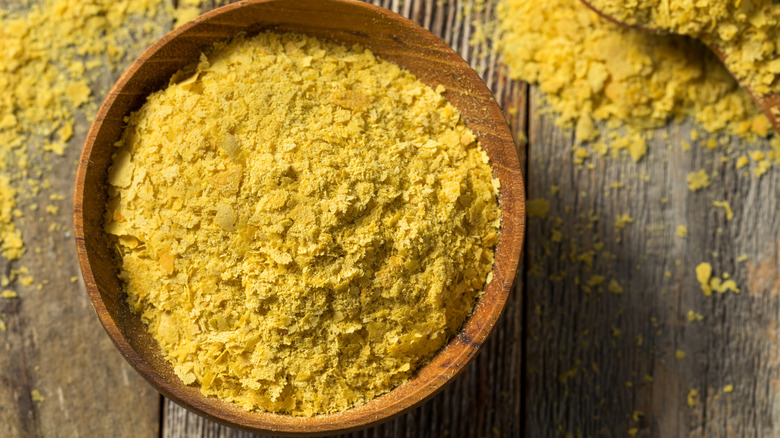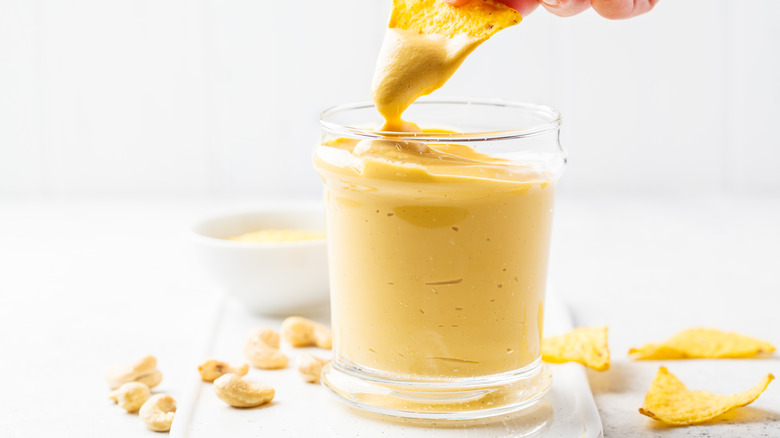What Exactly Is Nutritional Yeast And How Is It Used?
When most people think of yeast, they think of proofing homemade bread, a hoppy beer, or a fruity kombucha. Yeast has served very important culinary purposes dating back 5,000 years ago to the Egyptians. There's solid evidence it was used before written language was even established, per Red Star.
One of its forms, nutritional yeast, gained popularity as a health food amongst hippies circa the early 1970s. Dubbed "nooch," perhaps to offset its less-than-appetizing alias, the tiny flakes of gold earned a spot as a staple in vegetarian cuisine and on health food store shelves across the globe (via Good Food).
With the rise of plant-based eating, paleo diets, and dairy sensitivities, the nooch is experiencing somewhat of a resurgence and piquing interest amongst the health-conscious and curious — so much so that it's forecasted to reach a global market value of $999.5 million by 2032, per Fact.MR. Such a surge in trend deserves some exploration. What exactly is nutritional yeast, how should you use it, and is it really all that nutritious?
How nutritional yeast is made
Nutritional yeast is made from a species of fungus called Saccharomyces Cerevisiae, per Clean Green Simple. The fungus is grown and fed on beet or sugar cane molasses. After a few days, a fermented liquid layer is harvested and separated to make a cream yeast. It is then pasteurized, dried, and rolled into flakes or made into a powder. Brewer's and baker's yeast are made from the same fungus, but do not undergo the drying process, since it deactivates the leavening properties of the yeast. This is what mainly differentiates nutritional yeast from yeast as we know it, and renders it unsuitable for baking and brewing alcoholic beverages (via Superfood Evolution).
The two nutritional yeast varieties you come across at the store are fortified and unfortified. Fortified nutritional yeast contains added vitamin B12, potassium, and folic acid and typically has a brighter, golden color due to the B vitamins. Unfortified versions are much paler and lighter in color.
How to use nutritional yeast
Nutritional yeast is known for adding a cheesy flavor sans any dairy or animal products. That elusive umami flavor is due to the presence of glutamic acid, an amino acid present in plant and animal proteins that is naturally found in yeast products. It's abundant in cured meats and cheeses, hence the savory flavor it imparts to the yeast flakes (via The Weston A. Price Foundation). Many people also describe the taste of nutritional yeast as "nutty." This is due to the heating part of the process that inactivates the leavening properties of the yeast. That heat serves basically toasts the dried yeast, per Daily Harvest.
Given its cheesy, nutty flavor, nutritional yeast is best used just like cheese, specifically parmesan, thanks to its saltiness. It's great sprinkled on vegetables, popcorn, and pasta. It's also a wonderful addition to soups, sauces, or mixed into scrambled eggs. The flakes are also a flavorful and gluten-free alternative to bread crumbs that you can use when breading meats or tofu, per Bob's Red Mill.
Nutritional yeast is nutritious
The process by which nutritional yeast is grown also enhances its nutritional properties — hence its moniker, per Clean Green Simple. A research review published in Metabolites in 2022 found that nutritional yeast contains many important minerals, including calcium, copper, iron, phosphorus, potassium, magnesium, manganese, selenium, sodium, and zinc. It may also play a role in blood sugar regulation and be helpful in diabetes management, though further research is needed.
Fortified nutritional yeast is an excellent source of vitamin B12 for vegetarians and vegans. All nutritional yeast is a complete protein, meaning it contains all nine essential amino acids that are found in meat and animal products. It also contains a type of fiber that has been linked to lowering cholesterol and boosting immunity. Nutritional yeast contains antioxidants that fight free radicals and inflammation, and promote general health. It's low in calories, sodium, and carbs (via Parade).
While it's chock full of health benefits, those who have yeast sensitivities, digestive disorders, or are prone to migraines may want to limit or avoid nutritional yeast, per WebMD.



